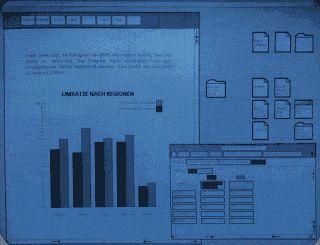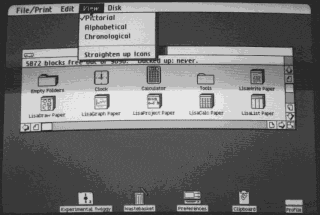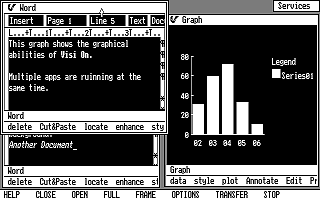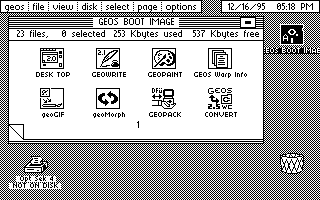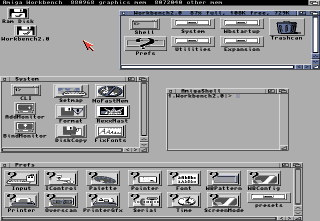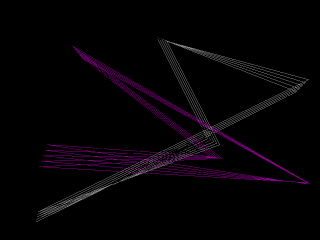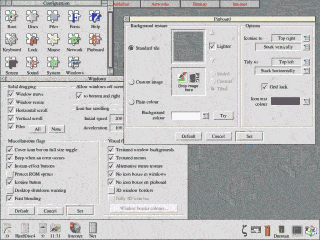History of the graphical user interface
The graphical user interface, or "GUI", is a computer interface that uses graphic icons and controls in addition to text. The user of the computer utilizes a pointing device, like a mouse, to manipulate these icons and controls. This was a great leap forward from the command line interface used in other operating systems, in which the user types a series of text commands to the computer.Initial Developments
The first concept of a windowing system begins with the first real-time graphic display systems for computers, namely the SAGE Project and Ivan Sutherland’s Sketchpad.Augmentation of Human Intellect
Doug Engelbart’s Augmentation of Human Intellect project at SRI in the 1960s developed the On-Line System, which incorporated a mouse-driven cursor and multiple windows.Xerox PARC
Engelbart’s work directly led to the advances at Xerox PARC. Several people went from SRI to Xerox PARC in the early 1970’s. The Xerox PARC team codified the WIMP (windows, icons, menus and pointers/pull-down menus) paradigm, first pioneered on the Xerox Alto experimental computer, but which eventually appeared commercially in the Xerox 8010 (’Star’) system in 1981.Apple Lisa and Macintosh
Beginning in 1979, led by Jef Raskin, the Lisa and Macintosh teams at Apple Computer (which included former members of the Xerox PARC group) continued to develop such ideas. The Macintosh, released in 1984, was the first commercially successful product to use a GUI. A desktop metaphor was used, in which files looked like pieces of paper; directories looked like file folders; there were a set of desk accessories like a calculator, notepad, and alarm clock that the user could place around the screen as desired; and the user could delete files and folders by dragging them to a trash can on the screen.There is still some controversy over the amount of influence that Xerox’s PARC work, as opposed to previous academic research, had on the GUIs of Apple’s Lisa and Macintosh, but it is clear that the influence was extensive.
The Macintosh’s GUI has been revised with time since 1984, with a major update with System 7, and underwent its largest revision with the introduction of the "Aqua" interface in 2001’s Mac OS X.
VisiOn
Graphical user interface primarily designed for spreadsheets by the company that wrote the legendary VisiCalc spreadsheet. First introduced the "windows" concept and a mouse to the PC environment, in 1983. Preceded the first Microsoft Windows implementations. VisiOn never took off because it could not be used to run other MS-DOS applications and was buggy and expensive. Inspired the multitasking system DESQview.Amiga Intuition
Amiga computers developed a GUI in 1985 called Intuition. In this GUI directories were shown as filing cabinet drawers.The Amiga GUI was unique for its time because it featured a pop-up command line interface (CLI) for those times when a GUI does not offer enough control.
GEM
At the same time Microsoft was developing Windows in the 1980s, Digital Research developed the GEM Desktop GUI system. GEM was created as an alternative window system to run on IBM PC systems, either on top of MS-DOS (like Microsoft Windows) or on top of CPM-86, DR’s own operating system that MS-DOS was patterened after. GEM achieved minimal success in the PC world, but was later used as the native GUI on the Atari ST machines.GEOS
GEOS was another very early graphical desktop system. Originally written for the 8 bit home computer Commodore 64 it was later ported to IBM PC systems. It came with several application programs like a calendar and word processor, and a cut-down version served as the basis for America Online’s DOS client. Compared to the competing Windows 3.0 GUI, it could run reasonably well on simpler hardware.Revivals were seen in the HP OmniGo handhelds, Brother GeoBook line of laptop-appliances, and the New Deal Office package for PCs. Related code found its way to earlier ’Zoomer’ PDAs, creating an unclear lineage to Palm, Inc’s later work.
Microsoft Windows
Microsoft modeled the first version of Windows, released in 1985, on the GUI of the Mac OS. Windows 1.0 was a GUI (graphic user interface) for the MS-DOS operating system that had been the standard OS for with IBM PC and compatible computers since 1981. Windows 2.0 followed, then in 1990 the Windows 3.0 launch was when the popularity of Windows really exploded. The GUIs of subsequent versions of Windows have been similar to the GUI of Windows 3.0.In 1988, Apple sued Microsoft for copyright infringement of the Lisa and Apple Macintosh GUI. The court case lasted 4 years before almost all of Apple’s claims were denied. Subsequent appeals by Apple were also denied, and Microsoft and Apple apparently entered a final, private settlement of the matter in 1997 as a side note in a broader announcement of investment and cooperation.
RISC OS
Early versions of what became called RISC OS were known as Arthur, which was released in 1987. RISC OS was a colour GUI operating system which used three-buttoned mice, a taskbar (called the iconbar), and a file navigator similar to that of Mac OS. Acorn created RISC OS in the 1980s for their ARM- CPU based computers.NeXTSTEP
The NeXTSTEP user interface was used in the NeXT line of computers. NeXTSTEP’s first major version was released in 1989. It used Display PostScript for its graphical underpinning. The NeXTSTEP interface’s most significant feature was the Dock, carried into Mac OS X, and had other minor interface details that some found made it easier and more intuitive to use than previous GUIs. NeXTSTEP’s GUI was the first to feature opaque dragging of windows in its user interface, on a comparatively weak machine by today’s standards./H3> Originally collaboratively developed by Microsoft and IBM to replace DOS, version 1.0 (released in 1987) had no GUI at all. Version 1.1 (released 1988) included Presentation Manager (PM), which looked a lot like the later Windows 3.0 UI. After the split with Microsoft, IBM developed the Workplace Shell (WPS) for version 2.0 (released in 1992), a quite radical, object-oriented approach to GUIs. Microsoft later imitated much of this in Windows 95.
BeOSX Window System
The PostScript-based NeWS (Network extensible Window System) was developed by Sun Microsystems. For several years SunOS included a window system combining NeWS and the X Window System. Although NeWS was considered technically elegant by some commentators, Sun eventually dropped the product. Unlike X, NeWS was always proprietary software.The X Window System
The standard windowing system in the Unix world, developed in the early 1980s, is the X Window System, or X. X was developed at MIT as Project Athena. Its original purpose was to allow users of the newly emerging graphic terminals to access remote graphics workstations, without regard to the workstation’s operating system or the hardware. Due largely to the availability of the source code used to write X, it has become the standard layer for management of graphical and input/output devices and for the building of both local and remote graphical interfaces on virtually all systems, including UNIX, the BSD operating systems and the GNU/Linux distributions.X allows a graphical terminal user to make use of remote resources on the network as if they were all located locally to the user by running a single module of software called the X server. The software running on the remote workstation is called the client application. X’s network transparency protocols allow the display and input portions of any application to be separated from the remainder of the application and ’served up’ to any of a large number of remote users.
In the early days of X Window development Sun Microsystems and AT&T attempted to push for a GUI standard called OpenLook in competition with Motif. OpenLook was a well-designed standard developed from scratch while MOTIF was a collective effort that fell into place. Many who worked on OpenLook at the time appreciate its design coherence. Motif prevailed the ’religious’ war and became the bases for CDE (Common Desktop Environment). Both X and Open Motif are available today as free software.
In the late 1990s, there was significant growth in the Unix world, especially among the free software community. New graphical desktop movements grew up around GNU/Linux and similar operating systems, based on the X. A new emphasis on providing an integrated and uniform interface to the user brought about new desktop environments, KDE and GNOME.
See also:
- Apple v. Microsoft
- Bill Atkinson
- Doug Engelbart’s On-Line System
- Graphical user interface
- History of computing
- History of Microsoft Windows
- Ivan Sutherland’s Sketchpad
- Jef Raskin
- VisiOn history - The first GUI for the PC


